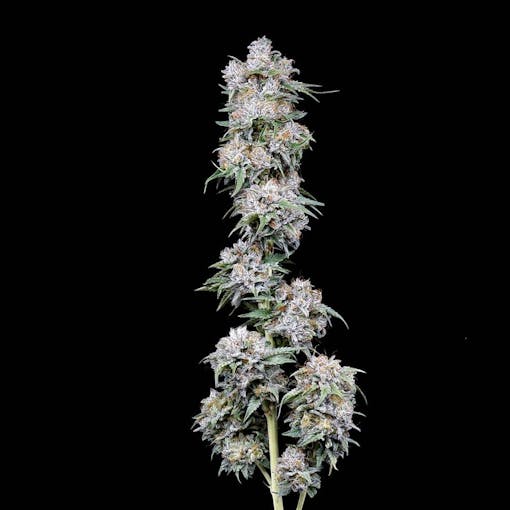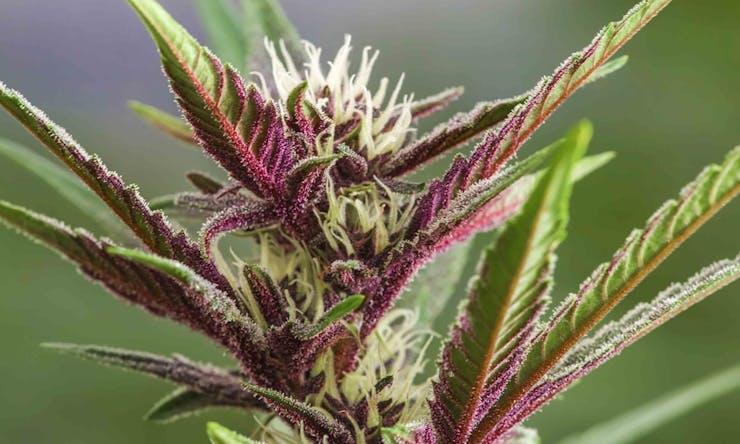Environment and genetics both play a role in the coloration of a plant. But what exactly causes each variety to look the way it does? What gives Black Cherry Soda its otherworldly color of dark purple with vibrant orange hairs cutting through it like streaks of fire?
Let’s explore the color of cannabis and examine which factors influence its coloration, why some strains are more vibrant than others, and whether purple = potent.
How do genetics influence the color of cannabis?

Black Cherry Soda.
In order for plants to express vibrant non-green hues, they need the genetic building blocks to do so. These building blocks are called anthocyanins, which are a family of flavonoids that provide purple, red, or blue pigments—these are also found in blueberries, eggplants, red cabbage, concord grapes, violets, and other richly colored plants. Some cannabis strains naturally contain higher levels of anthocyanins than others.
Ever notice some of your favorite strains tend to express the same colors over and over again? Granddaddy Purple, for example, seems to always carry swirls of deep purples and pastel lavenders.
This alternative coloration is indicative of the strain’s predisposition to high anthocyanin levels, and it’s certainly a quality some cannabis breeders attempt to select for and coerce, if only to make us consumers ooh-and-ahh over pretty colors (hence the long line of “purple” strains that includes Purple Kush, Mendocino Purps, Purple Urkle, and many others).
Which marijuana strains tend to turn purple, blue, or red?
Many strains contain a genetic predisposition for high anthocyanin levels, and you’ll often find them under monikers that begin with colors like purple, red, blue, or pink. No, this doesn’t mean these strains will always show off fancy hues, but they have a higher potential of doing so if conditions are right.
Plants with low anthocyanin may produce a different array of colors in the final weeks of flowering, due to another family of molecules called carotenoids. These are responsible for the earthy gold and yellow hues buds can take on before harvest as chlorophyll shuts off.

Super Lemon Haze.
How does cannabis go from green to purple?
As you might remember from your elementary biology classes, chlorophyll is what gives plants its green color. Chlorophyll is vitally important to the photosynthesis process by which plants absorb sunlight for energy.
As cannabis plants mature, they produce less of the dominant pigment chlorophyll and we begin to see those anthocyanins emerge in a show of purples, reds, and blues. Growers should note that there are specific environmental conditions that trigger the halt of chlorophyll production. We’ll get into that shortly.
What other environmental factors affect the color of cannabis?
Although not all cannabis strains will express purple, blue, or red hues in their lifetime, those equipped with the right genetics may do so under certain environmental conditions. The reason why cannabis produces flavonoids and anthocyanin, researchers have observed, is for protection.
“Flavonoid accumulation [is] involved in many aspects of plant growth,” the study authors wrote, “including pathogen resistance, pigment production, and protection against ultraviolet radiation, which contributes to the growth of pollen and seed coat development.”
Information on anthocyanin production in cannabis is limited. What we do know comes largely from cannabis cultivation experience and studies measuring patterns of anthocyanin production in other vegetation.
First, there’s temperature. Purple, red, and blue hues may appear in response to drops in temperature, since chlorophyll production takes its natural pause in autumn as the days become colder.
Research on other fruits and flowers noted that higher temperatures destroy anthocyanin production. That same study also found that higher pH levels lead to the destruction of anthocyanin pigments, meaning they tend to thrive in more acidic environments.
The pH level determines which pigment the plant takes on:
- Acidic environments tend to induce red and pink coloration
- Purple coloration occurs in neutral pH environments
- Blues become present with higher pH levels
- Yellow is developed in alkaline conditions
Are purple cannabis strains more potent?
They might be more eye-catching, but purple strains are not necessarily more potent than their green relatives. A purple-blossomed plant exposed to cold temperature may actually produce less THC, so it’s important to keep in mind, as Robert Clarke aptly puts it in The Cannabible, that “many traits prove to be desirable only in certain varieties under certain conditions.”
This post was originally published on March 21, 2016. It was most recently updated on July 28, 2020.





